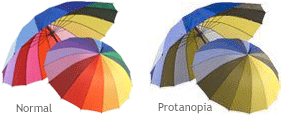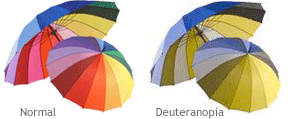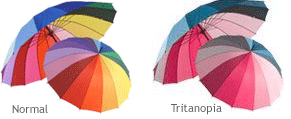Dichromacy
Dichromacy can be defined as a type of color blindness in which the patient either does not have or has weak cone cells in the retina. A patient of dichromacy is unable to recognize any two of these colors: blue, green or red. The reason for this condition is out of the three groups of cone cells in the retina one is usually missing. The cone cells are categorized into three colors: blue, green, and red. The lack of any one of these cone cells results in dichromacy.
The types of dichromacy are categorized according to the type of cone cells missing:
Protanopia

Protanopia is the most common type of dichromacy today. Patients suffering from protanopia do not have red cone cells in the retina. This means that these patients are unable to spot red color. Also, these patients have difficulty in spotting green color. Singly they are able to easily spot blue and green. However, with a combination of blue and green, they are unable to mark the difference and the color usually appears gray to them.
Deuteranopia

The condition of Deuteranopia is very similar to that of Protanopia. In this form of dichromacy, the patient does not have green cone cells in the retina making him or her unable to spot green color. Usually in deuteranopia and protanopia patients show the same symptoms.
When a mixture of green and red is presented to them they are unable to spot either one of the colors. But singly a deuteranopia patient can spot red color and the protanopia patient can spot green color.
Tritanopia

Tritanopia is the rarest form of dichromacy having a ratio of 10 in 1 million people. In this type of dichromacy, the patient is unable to distinguish between yellow and blue colors. The reason is because the patient does not have blue cone cells in the retina. Tritanopia is considered less
dangerous compared to the other two types of dichromacy. Patients of tritanopia do not usually have difficulty in recognizing colors that relate to green and red shades. Tritanopia is hereditary and is a rare disease. So few patients are found with this form of dichromacy that doctors believe it to be solely hereditary.
Information
Take a Test
Test your color vision online now with a test developed by a color vision specialist, Dr. Terrace L. Waggoner.
If you have any questions , please contact us at info@testingcolorvision.com.

